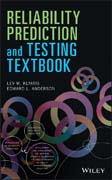
Reliability Prediction and Testing Textbook
Klyatis, Lev M.
Anderson, Oscar Edward
This textbook reviews the methodologies of reliability prediction as currently used in industries such as electronics, automotive, aircraft, aerospace, off–highway, farm machinery, and others. It then discusses why these are not successful; and, presents methods developed by the authors for obtaining accurate information for successful prediction. The approach is founded on approaches that accurately duplicate the real world use of the product. Their approach is based on two fundamental components needed for successful reliability prediction; first, the methodology necessary; and, second, use of accelerated reliability and durability testing as a source of the necessary data. Applicable to all areas of engineering, this textbook details the newest techniques and tools to achieve successful reliabilityprediction and testing. It demonstrates practical examples of the implementation of the approaches described. This book is a tool for engineers, managers, researchers, in industry, teachers, and students. The reader will learn the importance of the interactions of the influencing factors and the interconnections of safety and human factors in product prediction and testing. INDICE: Preface xiLev M. Klyatis and Edward Anderson .About the Authors xix .Introduction xxiiiLev M. Klyatis .1 Analysis of Current Practices in Reliability Prediction 1Lev M. Klyatis .1.1 Overview of Current Situation in Methodological Aspects of Reliability Prediction 1 .1.1.1 What is a Potential Failure Mode? 5 .1.1.2 General Model 6 .1.1.3 Classical Test Theory 6 .1.1.4 Estimation 7 .1.1.5 Reliability Prediction for Mean Time Between Failures 9 .1.1.6 About Reliability Software 9 .1.1.6.1 MIL–HDBK–217 PredictiveMethod 10 .1.1.6.2 Bellcore/Telcordia PredictiveMethod 11 .1.1.6.3 Discussion of Empirical Methods 11 .1.1.7 Physics of FailureMethods 12 .1.1.7.1 Arrhenius s Law 12 .1.1.7.2 Eyring and Other Models 12 .1.1.7.3 Hot Carrier InjectionModel 13 .1.1.7.4 Black Model for Electromigration 14 .1.1.7.5 Discussion of Physics of Failure Methods 14 .1.1.8 Life TestingMethod 15 .1.1.8.1 Conclusions 15 .1.1.8.2 Failure of the Old Methods 17 .1.1.9 Section Summary 23 .1.2 Current Situation in Practical Reliability Prediction 24 .1.3 From History of Reliability Prediction Development 27 .1.4 Why Reliability Prediction is Not Effectively Utilized in Industry 30 .References 35 .Exercises 40 .2 Successful Reliability Prediction for Industry 43Lev M. Klyatis .2.1 Introduction 43 .2.2 Step–by–Step Solution for Practical Successful Reliability Prediction 46 .2.3 Successful Reliability Prediction Strategy 48 .2.4 The Role of Accurate Definitions in Successful Reliability Prediction: Basic Definitions 49 .2.5 Successful Reliability Prediction Methodology 53 .2.5.1 Criteria of Successful Reliability Prediction Using Results of Accelerated Reliability Testing 53 .2.5.2 Development of Techniques for Product Reliability Prediction Using Accelerated Reliability Testing Results 63 .2.5.2.1 Basic Concepts of Reliability Prediction 63 .2.5.2.2 Prediction of the Reliability Function without Finding the Accurate Analytical or Graphical Form of the Failures Distribution Law 64 .2.5.2.3 Prediction Using MathematicalModelsWithout Indication of the Dependence Between Product Reliability and Different Factors of Manufacturing and Field Usage 65 .2.5.2.4 Practical Example 68 .References 70 .Exercises 71 .3 Testing as a Source of Initial Information for Successful Practical Reliability Prediction 75Lev M. Klyatis .3.1 How the Testing Strategy Impacts the Level of Reliability Prediction 75 .3.2 The Role of Field Influences on Accurate Simulation 80 .3.3 Basic Concepts of Accelerated Reliability and Durability Testing Technology 83 .3.4 Why Separate Simulation of Input Influences is not Effective in Accelerated Reliability and Durability Testing 88 .References 96 .Exercises 97 .4 Implementation of Successful Reliability Testing and Prediction 101Lev M. Klyatis .4.1 Direct Implementation: Financial Results 102 .4.1.1 Cost–Effective Test Subject Development and Improvement 107 .4.1.1.1 Example 1 108 .4.1.1.2 Example 2 109 .4.2 Standardization as a Factor in the Implementation of Reliability Testing and Prediction 110 .4.2.1 Implementation of Reliability Testing and Successful Reliability Prediction through the Application of Standard EP–456 Test and Reliability Guidelines for Farm Machinery 110 .4.2.2 How theWork in SAE G–11 Division, Reliability Committee Assisted in Implementing Accelerated Reliability Testing as a Component of Successful Reliability Prediction 111 .4.2.3 Development and Implementation of Reliability Testing during the Work for the International Electrotechnical Commission (IEC), USA Representative for International Organization for Standardization (ISO), Reliability and Risk (IEC/ISO Joint Study Group) 149 .4.3 Implementing Reliability Testing and Prediction through Presentations, Publications, Networking as Chat with the Experts, Boards, Seminars,Workshops/Symposiums Over theWorld 155 .4.4 Implementation of Reliability Prediction and Testing through Citations and Book Reviews of MyWork Around theWorld 183 .4.5 Why Successful Product Prediction Reliability has not been Widely Embraced by Industry 193 .References 194 .Exercises 195 .5 Reliability and Maintainability Issues with Low–Volume, Custom, and Special–Purpose Vehicles and Equipment 197Edward Anderson .5.1 Introduction 197 .5.2 Characteristics of Low–Volume, Custom, and Special–Purpose Vehicles and Equipment 198 .5.2.1 Product Research 202 .5.2.2 Vendor Strength 202 .5.2.3 Select a Mature Product 203 .5.2.4 Develop a Strong Purchase Contract 203 .5.2.5 Establish a Symbiotic Relationship 204 .5.2.6 Utilize Consensus Standards 204 .5.2.7 User Groups/Professional Societies 205 .5.2.8 Prerequisites 206 .5.2.9 ExtendedWarranties 206 .5.2.10 Defect/Failure Definitions/Remedies 206 .5.2.11 Pre–Award and/or Preproduction Meetings 207 .5.2.12 Variation 207 .5.2.13 Factory Inspections 210 .5.2.14 Prototype Functional or Performance Testing 210 .5.2.15 Acceptance Testing 210 .5.2.16 Lead the Fleet Utilization 212 .5.2.17 Reserves 212 .5.2.18 Problem Log 213 .5.2.19 Self–Help 213 .References 214 .Exercises 214 .6 Exemplary Models of Programs and Illustrations for Professional Learning in Reliability Prediction and Accelerated Reliability Testing 217Lev M. Klyatis .6.1 Examples of the Program 217 .6.1.1 Example 1. Several Days Course: Successful Prediction of Product Reliability and Necessary Testing 217 .6.1.2 Example 2. One–Day Course Methodology of Reliability Prediction 218 .6.1.3 Example 3. One Two Days Course (or tutorial) Accelerated Reliability and Durability Testing Technology as Source of Obtaining Information for Successful Reliability Prediction 219 .6.1.4 Example 4. One Two Days Seminar Foundation for Designing Successful Accelerated Testing 219 .6.2 Illustrations for these and Other Programs in Reliability Prediction and Testing 220 .6.2.1 Examples: Text for the Slides 220 .6.2.2 Examples of Figures 228 .Index 243
- ISBN: 978-1-119-41188-8
- Editorial: Wiley–Blackwell
- Encuadernacion: Cartoné
- Páginas: 288
- Fecha Publicación: 10/08/2018
- Nº Volúmenes: 1
- Idioma: Inglés
